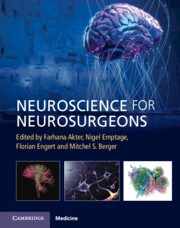Book contents
- Neuroscience for Neurosurgeons
- Neuroscience for Neurosurgeons
- Copyright page
- Contents
- Contributors
- Section 1 Basic and Computational Neuroscience
- Chapter 1 Neuroanatomy
- Chapter 2 Cerebral Autoregulation
- Chapter 3 Neuroimmune Interactions
- Chapter 4 Anatomy and Physiology of the Neuron
- Chapter 5 Synaptic Transmission
- Chapter 6 Sensory Pathways
- Chapter 7 Somatosensory and Somatic Motor Systems
- Chapter 8 Neuron Models
- Chapter 9 An Introduction to Artificial Intelligence and Machine Learning
- Chapter 10 Artificial Intelligence in Neuroscience
- Chapter 11 Probability and Statistics
- Section 2 Clinical Neurosurgical Diseases
- Index
- References
Chapter 10 - Artificial Intelligence in Neuroscience
from Section 1 - Basic and Computational Neuroscience
Published online by Cambridge University Press: 04 January 2024
- Neuroscience for Neurosurgeons
- Neuroscience for Neurosurgeons
- Copyright page
- Contents
- Contributors
- Section 1 Basic and Computational Neuroscience
- Chapter 1 Neuroanatomy
- Chapter 2 Cerebral Autoregulation
- Chapter 3 Neuroimmune Interactions
- Chapter 4 Anatomy and Physiology of the Neuron
- Chapter 5 Synaptic Transmission
- Chapter 6 Sensory Pathways
- Chapter 7 Somatosensory and Somatic Motor Systems
- Chapter 8 Neuron Models
- Chapter 9 An Introduction to Artificial Intelligence and Machine Learning
- Chapter 10 Artificial Intelligence in Neuroscience
- Chapter 11 Probability and Statistics
- Section 2 Clinical Neurosurgical Diseases
- Index
- References
Summary
Neurosurgeons have the privilege of peeking inside the most precious and the most mysterious device on earth: the human brain. The human brain is also the most expensive device on earth given that mental health problems constitute the largest health care cost. By deciphering the inner secrets of brain computations, scientists and engineers have taken inspiration to develop smart artificial intelligence(AI) algorithms. These AI algorithms in turn provide much help to understanding brain function and to multiple applications in brain disorders, including neurosurgery.
- Type
- Chapter
- Information
- Neuroscience for Neurosurgeons , pp. 158 - 166Publisher: Cambridge University PressPrint publication year: 2024



